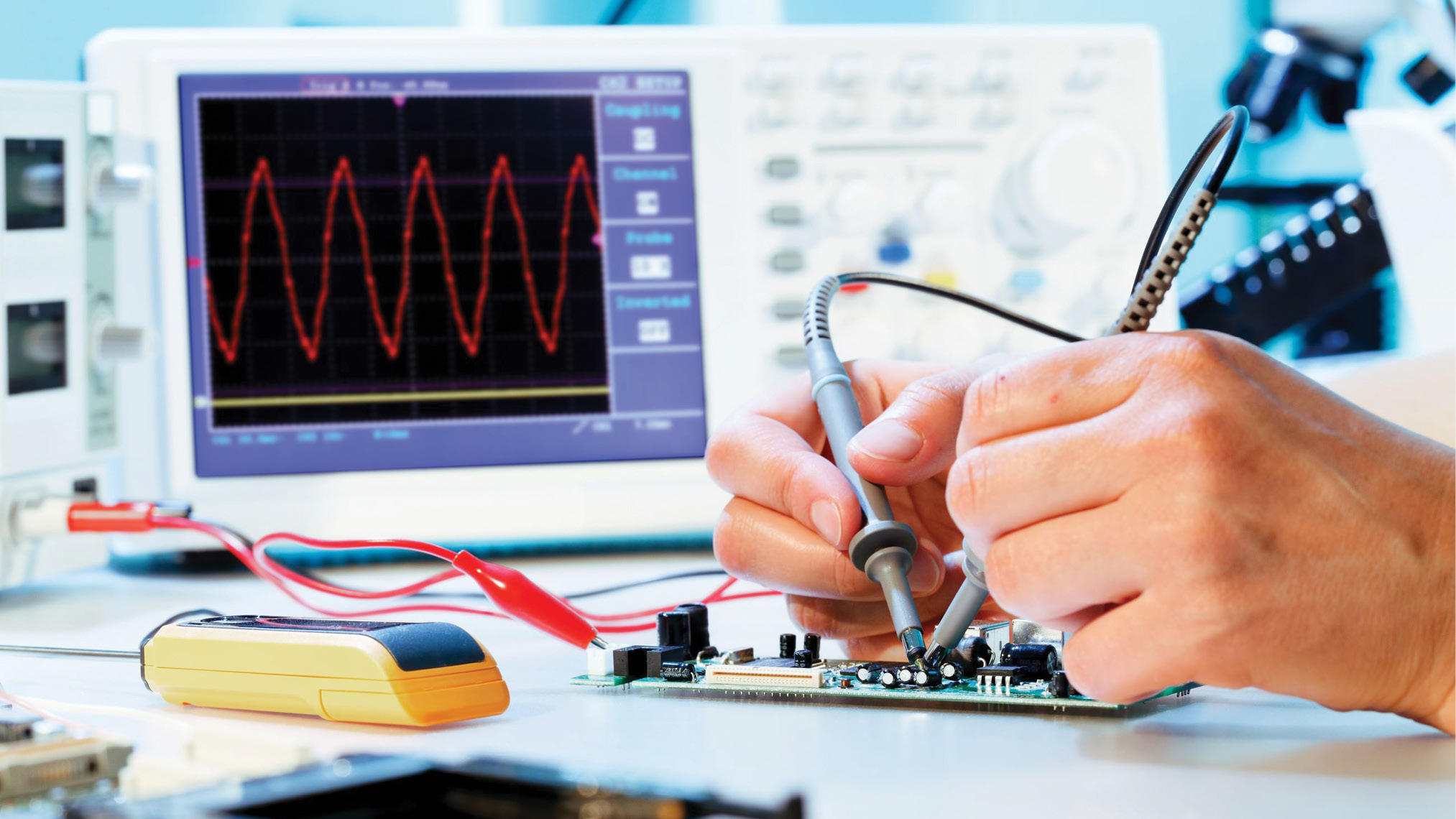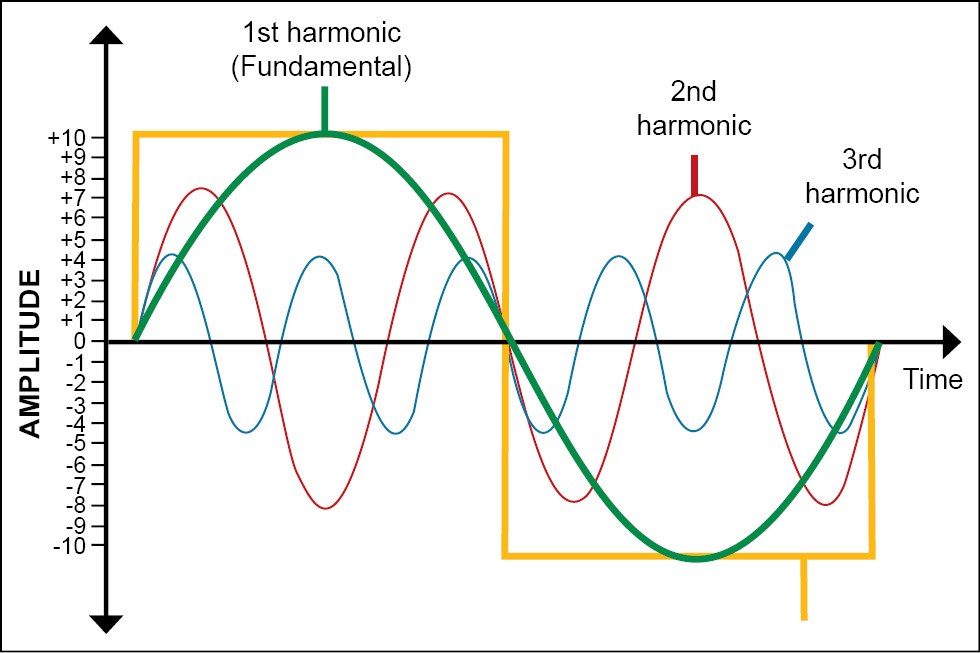An oscilloscope is a device that displays an electrical signal in the form of a graph. The graph in most cases shows how the signal changes over time. Y-axis represents voltage and X-axis represents time. These simple graphs can be used to extract highly useful information about the signals, such as amplitude, frequency, time period, rise time, duty cycle, jitter and much more.

Oscilloscopes can be classified as analogue and digital. Analogue oscilloscopes trace signals but digital oscilloscopes sample signals and construct waveforms on the display. Digital oscilloscopes use an analogue-to-digital converter (ADC) to convert the measured voltage into digital information. They acquire the waveform as a series of samples. These samples are continuously stored in the memory until the oscilloscope has enough samples to describe a waveform. The digital oscilloscope then reproduces the waveform on the screen by using the stored samples.
Digital oscilloscopes are further classified into digital storage oscilloscope (DSOs), digital phosphor oscilloscope (DPOs), mixed-signal oscilloscope (MSOs) and digital sampling oscilloscopes. Here we will discuss only digital storage oscilloscope. A digital storage oscilloscope allows you to capture and view transients. Since the signal information exists in digital form as a series of stored digital codes, it can be processed easily by the oscilloscope itself or by an external computer to extract various results from the measurements. The waveform can also be displayed even after the signal has disappeared.
Why do you need an oscilloscope?
A good oscilloscope is an indispensable tool for anyone who is into design, testing or repair of electronic equipment. The oscilloscope helps you visualize the functioning of electronic circuits better. If you are into design, the detailed measurements can help you optimize your design for improved performance. In testing, a good insight into the circuit can be gained very quickly using an oscilloscope. Repairing becomes easy and quick with a tool to measure accurately at various test-points. These days, engineers need the best tools available to solve their measurement challenges quickly and accurately, and a digital storage oscilloscope is the best tool to do that.
Why is it important to select the right oscilloscope?
Accurate signal capture is of utmost importance for test and measurement equipment as all your decisions rely on the measured values. You can have correct measurement only when your oscilloscope is compatible with the range of signals you are trying to measure. That is why it is important to have a pretty good idea about the signals that you are going to measure before you buy an oscilloscope. Once you know your signals, you need to understand specifications in the datasheet to select an oscilloscope that will accurately measure all your signals. Also consider its upgradeability to meet your future needs.
Technical specifications
While looking at technical specifications, check whether the values are guaranteed or typical. You cannot completely rely on the typical value of any specification as it will give you only an idea of the oscilloscope’s performance. To have the measurement that complies with various quality standards, you need guaranteed specifications.

Technical specifications mentioned in a datasheet are usually difficult to understand. For easy understanding, we can divide specifications into three groups: measurement accuracy, measurement convenience and construction.
Specifications governing measurement accuracy
First, ascertain the signals that you are going to measure. To make sure that the oscilloscope measures all your signals accurately, the below-mentioned specifications of the oscilloscope need to comply with your signals’ range.
Bandwidth
Bandwidth indicates an oscilloscope’s fundamental ability to measure a signal. It determines the maximum frequency signal that the oscilloscope can accurately measure. Accuracy decreases with increase in the signal’s frequency. Bandwidth mentioned in the datasheet (say, 100 MHz) is actually the frequency at which a sinusoidal input is attenuated to 70.7 per cent of its true amplitude. Beyond this frequency the oscilloscope cannot support reasonable accuracy.
The oscilloscope must have suitable bandwidth to accurately measure your signals. To decide how much bandwidth you need, find out the range of frequencies you would need to measure, then multiply the maximum frequency by ‘five.’ For example, to measure a signal with 10MHz frequency accurately, you need an oscilloscope with 50MHz bandwidth. Otherwise, high-frequency changes are not resolved and the amplitude is distorted.
In case of digital signals, it is important to capture the fundamental, third and fifth harmonics to display accurate results (as shown in the figure). Therefore the bandwidth of the scope, together with the probe, should be at least five times the frequency of the measured signal.
Rise time
Analogue engineers find bandwidth more interesting, but for a digital engineer rise time is critical. Carefully consider rise time specifications if you will be working with digital signals. Choose an oscilloscope with sufficient rise time to accurately capture the details of fast transitions. An oscilloscope with faster rise time will more accurately capture critical details of a fast transitioning signal.
As a thumb rule, similar to bandwidth, the rise time of the oscilloscope should be less than one-fifth of the fastest rise time of the signal to accurately measure it. For example, for a 5 ns rise-time signal, an oscilloscope with less than 1 ns rise time is required.
Sample rate
Sample rate refers to how frequently a digital oscilloscope takes a sample of the signal. The faster the oscilloscope samples, the lesser the details lost while reconstructing the signal. In order to accurately reconstruct a signal and avoid aliasing, the Nyquist theorem states that the signal must be sampled at least twice as fast as its highest-frequency component. This theorem assumes an infinite record length and a continuous signal, but no oscilloscope can offer infinite record length. Therefore sampling at only twice the rate of highest-frequency component will not suffice.
The sampling rate that you require to accurately read your signal will majorly depend on the method used for reconstructing the signal—also called interpolation. For accurate reconstruction using sin(x)/x interpolation, sample rate should be at least 2.5 times the highest-frequency component of your signal. Using linear interpolation, the sample rate should be at least ten times the highest-frequency signal component.
Record length
The oscilloscope cannot store infinite number of samples as assumed by Nyquist equation. Record length determines the time that can be captured by each channel of the oscilloscope:
Time captured = Record length/Sample rate
Normally, entry-level oscilloscopes come with 2 to 2.5k points, which is more than enough. In general, the greater the record length, the better. To capture and debug serial bus, you need record length as high as 1M points.
External trigger
External triggers allow you to stabilize repetitive waveforms and make them appear static on the display by continuously displaying the same section of the input signal. Buy an oscilloscope that offers a wider range of triggering.
Generally, oscilloscopes are available with edge- and pulse-width trigger. Advance triggering options like A and B sequence, video, communication (CAN, SPI, etc) and logic triggering can help you debug faster.
Waveform capture rate
Sample rate indicates how fast an oscilloscope samples the input signal within one waveform, but the waveform capture rate refers to how quickly an oscilloscope captures a waveform. An oscilloscope with higher waveform capture rate captures fast transients better.
Number of channels
While deciding the number of channels, look at your future needs too. Increase in the number of channels adds a lot to the cost. Beware of those manufacturers who offer more channels by compromising the sample rate.
Probe specifications
Probe specifications are as important as the oscilloscope specifications because all measurements will start from the probes. The probe’s bandwidth should match the scope’s bandwidth. Here also the five times thumb rule will work perfectly.
The probe will be in direct contact with the circuit, so the circuit should not overload it. Otherwise, the measurement will not be correct. Resistive loading greater than 10 mega-ohms and capacitive loading less than 10 pico-farads is acceptable.
Specifications related to measurement convenience
Easy-to-use user interface, advanced automated measurements and convenient operation can really speed up your work. Below are the specifications that you need to check for measurement convenience.

Automated waveform measurements
Automated waveform measurement function helps you get numerical readings without any hassles. Most basic digital oscilloscopes provide this function where you can choose parameters like amplitude, frequency and time period, or have all of them together on the screen. Now if you measure any waveform, the display will show the graph along with numerical values of the parameters that you have selected.
Waveform math
This function provides automatic calculations for mathematical functions like integration, differentiation, FFT and logarithm.
User interface
The oscilloscope should be easy to use with an intuitive menu. This helps a beginner to immediately get started with his work. With dedicated knobs for frequently used functions, reading the waveforms becomes handy.
Convenience of waveform navigation and analysis is highly important as, at the end of the day, you would want to navigate the waveform that you have captured, and would also want to analyse it to extract useful information. Look for options like zoom and pan, interesting mark points and search options. Such features reduce the time to debug applications to a great extent.
In-built automated test
In-built automated tests like pass/fail test are sometimes very useful to quickly identify a problem. Such tests monitor your system continuously and inform about an error through a message on the display or some sound. Some oscilloscopes also log the history of these test results, which can be very handy to analyse the errors that occurred in the system.
Connectivity
Connectivity of an oscilloscope is highly important as you will always need to analyse and share the measurements. It can also help a lot while documenting your work. A lot of interfaces like GPIB, Ethernet, RS-232 and USB are available in oscilloscopes. Some advanced oscilloscopes also let you edit your documents and print them, or send via the Internet.
Specifications related to physical construction
Buy an oscilloscope that suits your work environment. For harsh environments, you need a rugged scope. Below-mentioned specifications can help you judge an oscilloscope for your work environment.
Display
Smaller displays are very uncomfortable. It becomes very difficult to analyse some high-frequency signals or bus on a small display. Look for an oscilloscope that has comparatively bigger display size. Colour displays are pleasing to the eyes and make it easy to distinguish signals by representing them in different colours. Entry-level oscilloscopes are generally available with a 14.4cm (5.7-inch) display.
Dimensions and weight
Dimensions and weight should be carefully selected depending on your work environment. If you work in the field, you will not be able to carry around a big oscilloscope. Taking measurements with it will also be very uncomfortable. So look for a small-size and light-weight oscilloscope.
Feel interested? Check out other posts on oscilloscopes.







